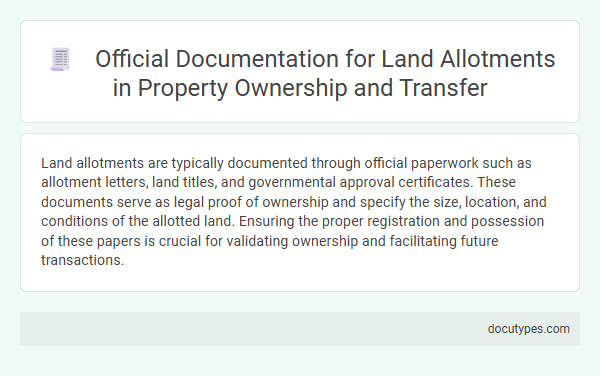Land allotments are typically documented through official paperwork such as allotment letters, land titles, and governmental approval certificates. These documents serve as legal proof of ownership and specify the size, location, and conditions of the allotted land. Ensuring the proper registration and possession of these papers is crucial for validating ownership and facilitating future transactions.
Introduction to Land Allotment Documentation
| Introduction to Land Allotment Documentation | |
|---|---|
| Land Allotment Certificate | This official document serves as proof of allotment and details the specifics of the assigned property, including boundaries and size. |
| Title Deed | A legal paper establishing ownership rights over the allotted land, essential for any future transactions or legal claims. |
| Land Survey Report | Prepared by certified surveyors, this report includes precise measurements and geographic information about the property. |
| Mutation Register Entry | Records the transfer of land ownership in government records, ensuring your name is officially registered as the owner. |
| Possession Letter | Issuance of this letter confirms your right to physically take possession of the allotted land. |
| Land Use Permission | Certain land allotments require permits specifying authorized uses, ensuring compliance with zoning and development regulations. |
Legal Framework Governing Land Allotments
What official paperwork is issued for land allotments? The primary documents include land titles, allotment letters, and legal agreements that establish ownership and usage rights. These papers serve as evidence of your legal claim under the specific regulations defined by the land allotment authority.
What legal framework governs land allotments? Land allotments are regulated by statutory laws, land revenue codes, and local government policies that define eligibility, allocation procedures, and dispute resolution mechanisms. This framework ensures transparency and protects your rights while managing land distribution effectively.
Key Types of Official Land Ownership Documents
When you receive a land allotment, there are specific official paperwork documents issued to establish ownership and legal rights. Understanding these key documents helps protect your property interests effectively.
- Land Title Deed - This document proves your legal ownership of the land and contains detailed information about the property boundaries.
- Allotment Letter - Issued by a government agency, this letter confirms the allotment of a particular land parcel to you.
- Property Tax Receipt - A receipt that verifies payment of property taxes, supporting your ownership claims.
Having these official land ownership documents ensures clear and undisputed rights to your allotted property.
Step-by-Step Process for Land Allotment Documentation
Land allotment involves submitting an application to the local land revenue office or municipal authority. This initiates the process of verifying ownership and eligibility for the allotment.
A site inspection is conducted by government officials to assess the property's boundaries and suitability. Approval is granted based on compliance with zoning laws and land use regulations.
Upon approval, an allotment letter or certificate is issued, serving as the official document confirming your right to the land. This letter includes detailed information about the plot area, location, and allotment terms.
Next, you must register the land document at the sub-registrar's office to obtain a sale deed or possession certificate. This step legally transfers ownership and completes the land allotment documentation process.
Mandatory Requirements for Land Transfer Documentation
Land allotments require specific official paperwork that verifies ownership and legal rights. Proper documentation ensures compliance with land transfer laws and protects both buyers and sellers.
- Title Deed - A legal document proving ownership of the land, essential for all land transfers.
- Sale Agreement - A mandatory contract outlining terms and conditions between the buyer and seller.
- Encumbrance Certificate - A certificate confirming the land is free from monetary or legal liabilities.
Verification and Validation of Land Allotment Papers
Official paperwork for land allotments typically includes the land allotment certificate, title deed, and survey maps issued by government authorities. Verification of these documents involves checking the authenticity with local land registry offices and confirming the allocation against government records. Validation ensures the paperwork is legally recognized, free from disputes, and accurately reflects the land boundaries and ownership.
Role of Government Agencies in Land Documentation
Government agencies play a crucial role in issuing official paperwork for land allotments. These documents ensure the legal recognition and protection of your property rights.
- Land Title Deed - This certificate confirms ownership and is issued by the land registry office.
- Allotment Letter - Provided by local municipal authorities, it authorizes the transfer or allocation of land.
- Survey Map - Issued by survey departments, it visually details the boundaries and dimensions of the land.
Common Pitfalls and Errors in Land Documentation
Land allotments typically come with official paperwork such as a land deed, allotment letter, or title certificate. These documents serve as legal proof of ownership and specify the exact boundaries and conditions of the property.
Common pitfalls in land documentation include discrepancies in the property boundaries, missing signatures, and unclear descriptions. Errors in these papers can lead to legal disputes and complications during property transactions, so careful verification is crucial.
Digitalization and E-Documentation for Property Transfers
Land allotments now often come with official paperwork issued in digital formats, streamlining property transfers. E-documentation enhances transparency, reduces processing times, and ensures secure record-keeping for stakeholders.
Digital land title certificates, electronic mutation registers, and online allotment orders have become standard in many regions. These digital documents are accessible through government portals, enabling easy verification and transfer of property rights. The integration of blockchain technology in some jurisdictions further secures the authenticity of land records and prevents fraud.
What Official Paperwork Is Issued for Land Allotments? Infographic

